Showing Spotlights 1961 - 1968 of 2783 in category All (newest first):
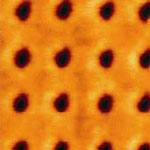 In developing next generation data storage devices, researchers are employing a variety of nanotechnology fabrication and patterning techniques such as electron-beam lithography, photolithography, microcontact printing, nanoimprinting and scanning probe microscope-based lithography. A decade ago, IBM for instance introduced the Millipede Project, a thermomechanical AFM-based nanopatterning technique that was aimed at data storage systems. While this system required an AFM tip heated to 350 degrees centigrade, researchers in Korea have now demonstrated that the writing, reading, and erasure of nanoscopic indentations on a polymeric film can be achieved by using an AFM tip at room temperature - no heating required.
In developing next generation data storage devices, researchers are employing a variety of nanotechnology fabrication and patterning techniques such as electron-beam lithography, photolithography, microcontact printing, nanoimprinting and scanning probe microscope-based lithography. A decade ago, IBM for instance introduced the Millipede Project, a thermomechanical AFM-based nanopatterning technique that was aimed at data storage systems. While this system required an AFM tip heated to 350 degrees centigrade, researchers in Korea have now demonstrated that the writing, reading, and erasure of nanoscopic indentations on a polymeric film can be achieved by using an AFM tip at room temperature - no heating required.
Sep 18th, 2009
 The batteries that power our everyday devices, from laptop computers, to mobile phones, watches, toys and flashlights, are a major source of pollution. The average household in the Western world uses about 20 batteries a year, resulting in hundreds of thousands of tons of discarded batteries that end up in landfills. When the battery casing corrodes, toxic heavy metals like mercury and cadmium can leak out and pollute soil and ground water. Researchers have been working on non-metal batteries but so far the performance of the used materials has not been good enough for commercial applications. One way to improve the performance of nonmetal-based energy storage devices is to use composite electrode materials of conductive polymers, deposited as thin layers on a suitable large surface area substrate. Researchers have now developed a novel polypyrrole-cellulose composite electrode material that is mechanically robust, lightweight, and flexible.
The batteries that power our everyday devices, from laptop computers, to mobile phones, watches, toys and flashlights, are a major source of pollution. The average household in the Western world uses about 20 batteries a year, resulting in hundreds of thousands of tons of discarded batteries that end up in landfills. When the battery casing corrodes, toxic heavy metals like mercury and cadmium can leak out and pollute soil and ground water. Researchers have been working on non-metal batteries but so far the performance of the used materials has not been good enough for commercial applications. One way to improve the performance of nonmetal-based energy storage devices is to use composite electrode materials of conductive polymers, deposited as thin layers on a suitable large surface area substrate. Researchers have now developed a novel polypyrrole-cellulose composite electrode material that is mechanically robust, lightweight, and flexible.
Sep 16th, 2009
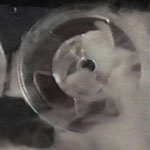 A hallmark of the Mission: Impossible series shows secret agent Phelps receiving his instructions on a tape that then self-destructs and goes up in a cloud of smoke. Existing self-erasing media are much less dramatic, of course. Most of these materials rely on photochromic molecules. One prominent example is an experimental printing technology with reusable paper developed by Xerox and PARC. While writing with light can be both rapid and accurate, photochromic 'inks' are not necessarily optimal for transforming light-intensity patterns into color variations, because they have relatively low extinction coefficients, are prone to photobleaching, and usually offer only two colors corresponding to the two states of photoisomerizing molecules. Researchers at Northwestern University have now developed a new concept that can be used to produce self-erasing pictures. In contrast to previous techniques, their method allows for multicolored pictures.
A hallmark of the Mission: Impossible series shows secret agent Phelps receiving his instructions on a tape that then self-destructs and goes up in a cloud of smoke. Existing self-erasing media are much less dramatic, of course. Most of these materials rely on photochromic molecules. One prominent example is an experimental printing technology with reusable paper developed by Xerox and PARC. While writing with light can be both rapid and accurate, photochromic 'inks' are not necessarily optimal for transforming light-intensity patterns into color variations, because they have relatively low extinction coefficients, are prone to photobleaching, and usually offer only two colors corresponding to the two states of photoisomerizing molecules. Researchers at Northwestern University have now developed a new concept that can be used to produce self-erasing pictures. In contrast to previous techniques, their method allows for multicolored pictures.
Sep 15th, 2009
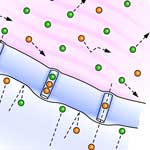 The interest in exploring the use of noble metal nanoparticles for diagnostic and therapeutic imaging stems from the drawbacks of current in vivo probes. Fluorescent probes, such as fluorescent dyes and proteins, are not photostable and therefore are useful only for a limited time during the probing event. Besides imaging agents, especially gold nanoparticles are also intensely researched as target-specific vehicles for drug delivery. Due to its inert chemical properties, gold has been widely considered as one of the most stable and biocompatible materials. But studies of the biocompatibility and toxicity of gold nanoparticles in various types of cells have yielded inconclusive results: some studies show a toxic effect and high-dependence of toxicity on nanoparticle size and surface functional groups, while other studies report no significant cytotoxicity. Many of these studies did not use purified gold nanoparticles, or examine any other chemicals present in the gold nanoparticle solutions, or well characterize the physical properties, leading to these inconclusive results. Researchers have now synthesized and characterized stable, nearly monodisperse, and highly purified gold nanoparticles, and utilized them to study cleavage-stage embryos in real-time and to probe their effects on embryonic development at the single-nanoparticle level in real time.
The interest in exploring the use of noble metal nanoparticles for diagnostic and therapeutic imaging stems from the drawbacks of current in vivo probes. Fluorescent probes, such as fluorescent dyes and proteins, are not photostable and therefore are useful only for a limited time during the probing event. Besides imaging agents, especially gold nanoparticles are also intensely researched as target-specific vehicles for drug delivery. Due to its inert chemical properties, gold has been widely considered as one of the most stable and biocompatible materials. But studies of the biocompatibility and toxicity of gold nanoparticles in various types of cells have yielded inconclusive results: some studies show a toxic effect and high-dependence of toxicity on nanoparticle size and surface functional groups, while other studies report no significant cytotoxicity. Many of these studies did not use purified gold nanoparticles, or examine any other chemicals present in the gold nanoparticle solutions, or well characterize the physical properties, leading to these inconclusive results. Researchers have now synthesized and characterized stable, nearly monodisperse, and highly purified gold nanoparticles, and utilized them to study cleavage-stage embryos in real-time and to probe their effects on embryonic development at the single-nanoparticle level in real time.
Sep 11th, 2009
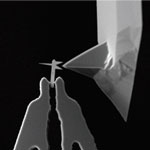 The folks at the European NanoHand project, whose nanogripper design we have covered in a previous Nanowerk Spotlight, seem to have loved playing with their plastic toy kits as kids. At least that's the impression you get when watching their latest video explaining their proof-of-principle study of scanning probe tips defined by planar nanolithography and integrated with AFM probes using nanomanipulation. They have prefabricated nanoscale needles, to be picked up by nanogrippers inside a scanning electron microscope. They then use these nanobits as ultralong tips in atomic force microscopes. The researchers call the needles 'nanobits' because they are a reminder of drill bits - you can have a library of different nanobits and then pick the one you want, and mount it where you want it.
The folks at the European NanoHand project, whose nanogripper design we have covered in a previous Nanowerk Spotlight, seem to have loved playing with their plastic toy kits as kids. At least that's the impression you get when watching their latest video explaining their proof-of-principle study of scanning probe tips defined by planar nanolithography and integrated with AFM probes using nanomanipulation. They have prefabricated nanoscale needles, to be picked up by nanogrippers inside a scanning electron microscope. They then use these nanobits as ultralong tips in atomic force microscopes. The researchers call the needles 'nanobits' because they are a reminder of drill bits - you can have a library of different nanobits and then pick the one you want, and mount it where you want it.
Sep 9th, 2009
 A few years ago it was discovered that the process of thermal inkjet printing can be applied to fabricate hard tissue scaffolds and, just recently, soft tissue with liquid biomaterials. Research is also underway to use inkjet printing for the fabrication of organic semiconductors, opening a route to the fabrication of high-performance and ultra low-cost electronics such as transparent electronics and thin film solar cells. As a matter of fact, the installation of the world's first silicon-ink based solar cell pilot production was completed this January. In your office, though, you have a choice between inkjet printers and (usually much faster) laser printers. And soon, nanotechnologists might have this choice, too. Researchers in California have demonstrated a novel technique for rapidly 'printing' various nanoparticles such as gold nanoparticles, carbon nanotubes, and semiconducting and metallic nanowires, on a photoconductive surface by light, much like a laser printer prints toner powder on paper.
A few years ago it was discovered that the process of thermal inkjet printing can be applied to fabricate hard tissue scaffolds and, just recently, soft tissue with liquid biomaterials. Research is also underway to use inkjet printing for the fabrication of organic semiconductors, opening a route to the fabrication of high-performance and ultra low-cost electronics such as transparent electronics and thin film solar cells. As a matter of fact, the installation of the world's first silicon-ink based solar cell pilot production was completed this January. In your office, though, you have a choice between inkjet printers and (usually much faster) laser printers. And soon, nanotechnologists might have this choice, too. Researchers in California have demonstrated a novel technique for rapidly 'printing' various nanoparticles such as gold nanoparticles, carbon nanotubes, and semiconducting and metallic nanowires, on a photoconductive surface by light, much like a laser printer prints toner powder on paper.
Sep 8th, 2009
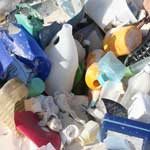 There is no denying the fact that plastic wastes have caused serious environmental problems - and continue to do so. Everyday plastic products, for instance water bottles or plastic bags from supermarkets, are so durable that they will either not rot at all or have long biodegradation periods of 50 years and more. Although so-called 'biodegradable' plastic products typically contain chemicals that help them fragment, the additives do not render the plastic biodegradable. While it is important to develop various techniques for the elimination of plastic wastes - landfills, incineration etc. - these solutions typically present several disadvantages such as re-entering the environment and cause re-pollution, loss of natural resources, or depletion of landfill space. Researchers in China have now developed a technique that uses waste plastics as carbon source for synthesizing silicon carbide nanomaterials. This may actually provide an effective method to help solve the environmental pollution of waste plastics.
There is no denying the fact that plastic wastes have caused serious environmental problems - and continue to do so. Everyday plastic products, for instance water bottles or plastic bags from supermarkets, are so durable that they will either not rot at all or have long biodegradation periods of 50 years and more. Although so-called 'biodegradable' plastic products typically contain chemicals that help them fragment, the additives do not render the plastic biodegradable. While it is important to develop various techniques for the elimination of plastic wastes - landfills, incineration etc. - these solutions typically present several disadvantages such as re-entering the environment and cause re-pollution, loss of natural resources, or depletion of landfill space. Researchers in China have now developed a technique that uses waste plastics as carbon source for synthesizing silicon carbide nanomaterials. This may actually provide an effective method to help solve the environmental pollution of waste plastics.
Sep 4th, 2009
 Humans have always tried to improve themselves through 'natural methods' such as physical exercise, diet, meditation, education and training. However, as a new report on human enhancement points out, with ongoing work to unravel the mysteries of our minds and bodies, coupled with the art and science of emerging technologies, we are near the start of the Human Enhancement Revolution. Technology will be a big game changer. While previously technological progress has improved the tools we work with, from the printing press to the steam engine to computers, in the future, technology will change ourselves, our bodies and, possibly, even our minds. A new addresses questions and issues surrounding human enhancement, an area that will become more prominent as advances in nanotechnology, nanomedicine, bionics, synthetic biology and related fields move from the lab to real-world applications.
Humans have always tried to improve themselves through 'natural methods' such as physical exercise, diet, meditation, education and training. However, as a new report on human enhancement points out, with ongoing work to unravel the mysteries of our minds and bodies, coupled with the art and science of emerging technologies, we are near the start of the Human Enhancement Revolution. Technology will be a big game changer. While previously technological progress has improved the tools we work with, from the printing press to the steam engine to computers, in the future, technology will change ourselves, our bodies and, possibly, even our minds. A new addresses questions and issues surrounding human enhancement, an area that will become more prominent as advances in nanotechnology, nanomedicine, bionics, synthetic biology and related fields move from the lab to real-world applications.
Sep 2nd, 2009
 In developing next generation data storage devices, researchers are employing a variety of nanotechnology fabrication and patterning techniques such as electron-beam lithography, photolithography, microcontact printing, nanoimprinting and scanning probe microscope-based lithography. A decade ago, IBM for instance introduced the Millipede Project, a thermomechanical AFM-based nanopatterning technique that was aimed at data storage systems. While this system required an AFM tip heated to 350 degrees centigrade, researchers in Korea have now demonstrated that the writing, reading, and erasure of nanoscopic indentations on a polymeric film can be achieved by using an AFM tip at room temperature - no heating required.
In developing next generation data storage devices, researchers are employing a variety of nanotechnology fabrication and patterning techniques such as electron-beam lithography, photolithography, microcontact printing, nanoimprinting and scanning probe microscope-based lithography. A decade ago, IBM for instance introduced the Millipede Project, a thermomechanical AFM-based nanopatterning technique that was aimed at data storage systems. While this system required an AFM tip heated to 350 degrees centigrade, researchers in Korea have now demonstrated that the writing, reading, and erasure of nanoscopic indentations on a polymeric film can be achieved by using an AFM tip at room temperature - no heating required.
 Subscribe to our Nanotechnology Spotlight feed
Subscribe to our Nanotechnology Spotlight feed





